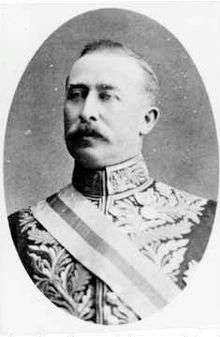Algernon Keith-Falconer, 9th Earl of Kintore
Algernon Hawkins Thomond Keith-Falconer, 9th Earl of Kintore, 9th Lord Keith of Inverurie and Keith Hall, Chief of Clan Keith, KT, GCMG, PC, FRSE (12 August 1852 – 3 March 1930), was a British politician and colonial governor.
The Earl of Kintore KT GCMG PC FRSE | |
|---|---|
 | |
| 12th Governor of South Australia | |
| In office 11 April 1889 – 10 April 1895 | |
| Monarch | Queen Victoria |
| Premier |
|
| Preceded by | Sir William Robinson |
| Succeeded by | Sir Thomas Buxton |
| Personal details | |
| Born | 12 August 1852 |
| Died | 3 March 1930 (aged 77) |
| Nationality | British |
Background and education
Born at Lixmount House, in Trinity, Edinburgh, Keith-Falconer was the eldest son of Francis Keith Falconer, 8th Earl of Kintore and his wife Louisa Madeleine, née Hawkins.[1] He was educated at Eton and Trinity College, Cambridge.[2]
Political career
In 1880, Lord Kintore was the unsuccessful Conservative candidate for Chelsea. He succeeded to his father's titles upon his father's death in 1880, was appointed First Government Whip in the House of Lords in 1885 and was a Lord-in-waiting from 1885 to 1886 and from 1895 to 1905. In 1886, he was invested as a Privy Counsellor. In 1913 he was elected a Deputy Speaker of the House of Lords.
Governor of South Australia
Lord Kintore was Governor of South Australia between 1889 and 10 April 1895. He was made a Knight-Grand-Cross of the Order of St Michael and St George (GCMG) on his appointment. A freemason, he was also Grand-Master of the United Grand Lodge of South Australia during his term as Governor (1889-1895).[3]
He arrived with his family at Adelaide in South Australia on 11 April 1889 aboard the Orient and was formally welcomed by the administrator, Chief Justice Samuel Way, who later resigned as Grand Master of the United Grand Lodge of South Australia in his favour.
Later life
In early 1901 he was asked by King Edward to take part in a special diplomatic mission to announce the King's accession to the governments of Denmark, Sweden and Norway, Russia, Germany, and Saxony.[4]
He was also a Knight of Grand-Cross of the Order of the Crown of Italy of Italy, a 1st Class of the Order of the Red Eagle of Prussia, a Grand-Cross of the Military Order of Our Lord Jesus Christ of Portugal and a Grand-Cross of the Order of the Polar Star of Sweden.
In 1911, Kintore was presented with a royal gift cigarette case by Prince Ferdinand of Bavaria (1884-1958). A century later, the gift featured in the Christie's London sale, SALE 7970 —IMPORTANT JEWELS held on 8 June 2011.[5]
Death
He died on 3 March 1930 aged 77 at 10 Park Place, St James Street, London, of acute bronchitis and periurethral abscess and interred on 7 March 1930 at Keith Hall, Inverurie, Aberdeen. He was survived by his wife, two sons and two daughters.
Family
Lord Kintore married Lady Sydney Charlotte Montagu (14 October 1851 – Keith Hall, Inverurie, Aberdeen, 21 September 1932), second daughter of George Montagu, 6th Duke of Manchester, at St George's, Hanover Square, London, on 14 August 1873.[6]
He was succeeded on the earldom by his second but only surviving son, Arthur. Kintore's daughter Lady Ethel Sydney Keith-Falconer, wife of John Baird, 1st Viscount Stonehaven, eventually inherited the earldom.
Legacy
Localities named for Earl Kintore include:
- Mt Kintore and the Kintore Range, Northern Territory - named by William Tietkens during his expedition of 1889[7]
- The town of Kintore, Northern Territory in the Kintore Range
- Kintore, Western Australia, now a ghost town, established in 1897 near Kalgoorlie. The Kintore gold mine was discovered in 1895. The Earl Kintore visited Western Australia at the time.[8]
Kintore's egernia, Liopholis kintorei, an Australian lizard, was named in 1893 in his honour.[9]
See also
References
- Lodge, Edmund (1858). The Peerage Of The British Empire. Oxford University. p. 334.
- "Inverurie, Lord Algernon Hawkins Thomond (INVY870AH)". A Cambridge Alumni Database. University of Cambridge.
- Henderson, Kent. "Vice-Regal Grand Masters - Who and Why?". Freemasonry. Archived from the original on 9 April 2013.
- "The King - the special Embassies". The Times (36410). London. 23 March 1901. p. 12.
- "AN EARLY 20TH CENTURY ROYAL PRESENTATION CIGARETTE CASE, BY CARTIER". Christie's.
- "Algernon Hawkins Thomond Keith-Falconer, 9th Earl of Kintore". The Peerage. pp. Person page 22278. Retrieved 10 December 2015.
- Long, Jeremy (1989). "Leaving the Desert: Actors and Sufferers in the Aboriginal Exodus from the Western Desert" (PDF). Aboriginal History. 13 (1): 14. Retrieved 20 January 2020.
- "Mining and Finance". Coolgardie Miner. 26 January 1895. p. 3. Retrieved 20 January 2020.
- Beolens, Bo; Watkins, Michel; Grayson, Michael (2011). The Eponym Dictionary of Reptiles. Baltimore: Johns Hopkins University Press. xiii + 296 pp. ISBN 978-1-4214-0135-5. ("Kintore", p. 141).
| Party political offices | ||
|---|---|---|
| Preceded by The Earl of Lathom |
Conservative Chief Whip in the Lords 1885–1889 |
Succeeded by The Earl of Limerick |
| Political offices | ||
| Preceded by The Earl of Dalhousie |
Lord-in-waiting 1885–1886 |
Succeeded by The Lord Camoys |
| Preceded by The Lord Monson |
Captain of the Yeomen of the Guard 1886–1889 |
Succeeded by The Earl of Limerick |
| Preceded by The Lord Henniker |
Lord-in-waiting 1895–1905 |
Succeeded by The Earl of Granard |
| Government offices | ||
| Preceded by Sir William Robinson |
Governor of South Australia 1889–1895 |
Succeeded by Sir Thomas Buxton |
| Peerage of Scotland | ||
| Preceded by Francis Alexander Keith-Falconer |
Earl of Kintore 1880–1930 |
Succeeded by Arthur George Keith-Falconer |
